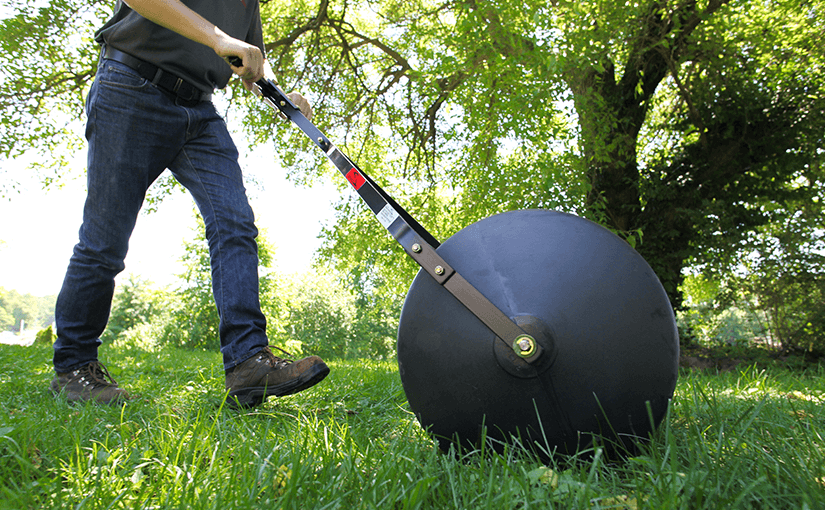At the mention of a lawn roller, many gardeners immediately think of large tools that are passed over the green area and level it. In the past, rolling was a typical maintenance step for home lawns, but nowadays it is usually only applied after the seed has been planted. For this reason, lawn owners wonder whether this method is useful at all and whether it can be applied afterwards, if it was forgotten after sowing.
Rolling the lawn
Is rolling the lawn useful or not? This question is often discussed among gardeners and lawn owners. Since lawn rolling leaves a noticeable impact on the soil, it is not recommended to use it in every case. The reasonable use depends on the situation. It is not always advisable to use the roller, because it worsens the structure of certain soils. The following points address the individual situations that are a good starting point for leveling the soil:
After sowing
Rolling the lawn is always recommended after the seed has been spread, as this allows it to be worked deeper into the soil and not easily blown away or be a found food for birds. In addition, washouts are less likely to occur, which typically can result from watering after seeding. For this reason, rollers are essential when establishing a new lawn.
Level out unevenness
If your soil is quite loose, causing bumps to form, this can lead to numerous depressions. In this case, you should apply the roller to smooth them out. Unevenness is very easy to level with the roller, as the weight distributes excess soil and thus fills holes. If you need to level unevenness, you should use the roller either before seeding, for example, when preparing the soil, or immediately after mowing. This is because after mowing, you can often see how uneven some parts of the lawn are due to a loose soil structure.
Pests
Similarly, rolling is an excellent means of improving soil plagued by pests. Voles and the classic visitors to the lawn, moles, are especially noteworthy here. The latter are known for their eager digging around the soil, which is reflected in numerous bumps and mounds.
Thanks to the constant force, these are repaired and the animals are disturbed in their work without hurting them. This method is applied only as needed. As soon as the first signs of burrowing activity appear again, you should reach for the roller, because this is the best time to do it.
It becomes problematic if you have a wet or heavy soil, which quickly compacts. In this case, it would be pointless to roll, because otherwise the soil will become even more compacted. In the long run, this will lead to extreme compaction of the lawn, which will not allow a dense lawn cover to form. Therefore, it does not make sense to roll already compacted lawns.
Likewise, it is not recommended if your lawn is currently suffering from a disease or infection. Especially fungi are problematic here. So in any case, consider the condition of your lawn before use.
Tip: If you do not want to use a roller, you can pull the entire surface with the rake after sowing, allowing the same effect. The individual tines allow the seeds to work well into the soil, while the soil spreads easily, creating a naturally level surface.
Subsequent rolling
Often more important is the question of whether it is possible to subsequently work the lawn with the roller. For example, if you forgot to perform this step after sowing, you will certainly want to reach for the roller.
But you should be careful here, because even in this case the timing must be right. As described above, you can only roll directly after sowing or mowing. For this reason, you should wait until the first mowing after sowing, which depends on the respective height of the blades:
- Ornamental lawn: 8 to 8.5 centimeters
- Sports turf: 7 to 7.5 centimeters
- Shade lawn: about 10 centimeters
In this way, you can accurately determine the time when the subsequent use of the lawn roller is possible. However, the problem with the subsequent use of the roller is the following:
- Soil can be compacted
- Seed is removed
- Soil dries out
Ideally, you should work the area with the roller within one day after seeding. You should not wait longer. After that, you need to wait a few weeks until the time comes to mow. After this you can apply the roller. In the waiting period until this date, you should not walk on the lawn too much, otherwise it may cause erosion.
Seeds sown can be removed by a lot of movement, which will cause gaps in the lawn. Don’t forget to water the lawn extensively over the waiting period. To prevent further unevenness during rolling, keep the following in mind:
- do not make tight turns
- long tracks are recommended
- run crosswise and lengthwise
Especially with loose soils, you should pay attention to these points, as they can be quite sensitive to the weight and shape of the roller.
Tip: If you do not have a lawn roller available yourself, you can use a board as an alternative and place it directly on the soil. Now stand on the board and gently tamp back and forth to smooth the soil and work the grass seeds into the soil.


